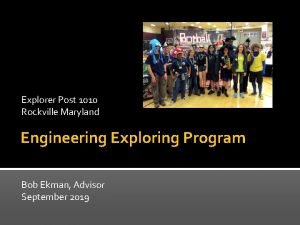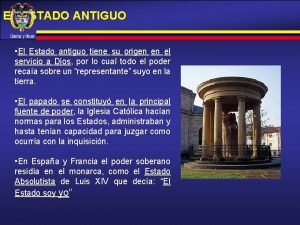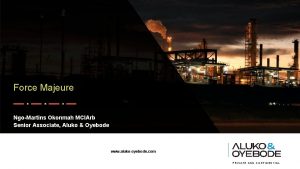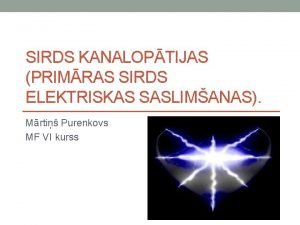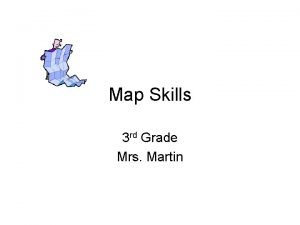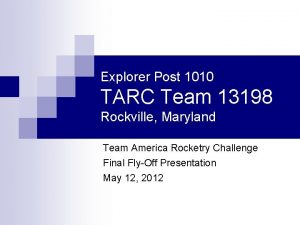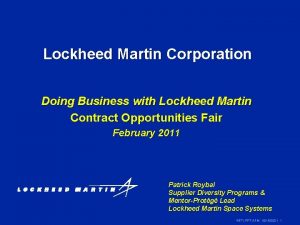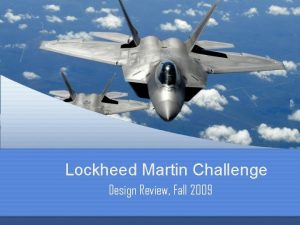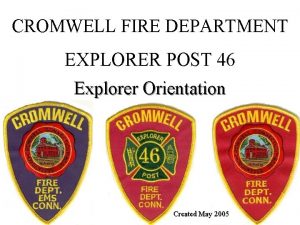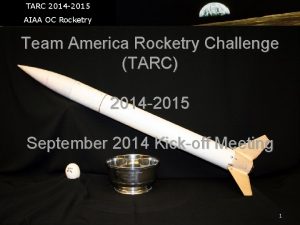Lockheed Martins Explorer Post 1010s Team 8189 TARC












- Slides: 12

Lockheed Martin’s Explorer Post 1010’s: Team 8189 TARC National Competition Seen enough rockets yet today? Jay Soni Connor Armstrong Stephen Redlack

“Magnum” (First Rocket) Engine: F 24 -4 W Mass (on final test): 413 g Booster Recovery: 10 X chute Cargo Recovery: 2 - 7”x 70” Streamers First Rocket This Team Has Ever Built. Photo courtesy of Explorer Post 1010 2

Flight Testing of “Magnum” November 21, 2009 (Mt. Airy, MD) -Test 1 Results: 770 feet high, 30 seconds long Additional Details: Egg broke -Test 2 Results: 907 feet high, 34 seconds long December 30, 2009 (Mt. Airy, MD) -Test 1 Results: 994 feet high, 40 seconds long -Test 2 Results: 806 feet high, 31 seconds long Additional Details: Used E 30 -4 T instead of F 24 -4 W January 16, 2010 (Mt. Airy, MD) -Test 1 Results: 838 feet high, 35 seconds long -Test 2 Results: 916 feet high, 26 seconds long Additional details: Used F 24 -7 W instead of F 24 -4 W 3 Photo courtesy of Explorer Post 1010

Last Test of “Magnum” February 27, 2010 (Manassas, VA) -Test 1 Results: 799 feet high, 15 seconds long Additional Details: -Official Qualification (Score: DQ) -Ejection charge failed; result of that shown below: It was given a proper burial. In our filing cabinet. Photo courtesy of Connor Armstrong 4

“Blue Steel” (New Rocket) Engine: F 24 -4 W Mass (most recent): 463 g Booster Recovery: 6”x 60” streamer Cargo Recovery (most recent): 3 - 7”x 70” Streamers Photo courtesy of Explorer Post 1010 5

Flight Testing of “Blue Steel” March 20, 2010 (Great Meadow, VA) -Test 1 Results: 744 feet high, 30 seconds long Additional Details: Used E 30 -4 T instead of F 24 -4 W 2 - 7”x 70” Streamers instead of 3 Not High Enough. -Test 2 Results: 659 feet high, 28 seconds long Additional Details: Used E 30 -4 T instead of F 24 -4 W 2 - 7”x 70” Streamers instead of 3 Definitely Not High Enough 6

Flight Testing of “Blue Steel” (Continued) March 20, 2010 (continued) -Test 3 Results: 925 feet high, 51 seconds long Additional details: 2 - 7”x 70” Streamers instead of 3 Too High, But The Time Is Proportional March 27, 2010 (Great Meadow, VA) -Test 1 Results: 838 feet high, 31 seconds long Additional details: 2 - 7”x 70” Streamers instead of 3 Great But Still Too Low and Too Short, Getting Closer. 7

Flight Testing of “Blue Steel” (Continued) March 27, 2010 (continued) -Test 2 Results: 859 feet high, 36. 5 seconds long Additional Details: Used 2 -7”x 70” streamers and 1 - 4”x 40” streamer Official Qualification (Score: 51. 6) First Official Qualifier, Not Good Enough For TARC Though. 8 Photo Courtesy of Iranians learning photo shop.

Miracle Test of “Blue Steel” Also on March 27, 2010 in Great Meadow, VA We decided to switch out the 4”x 40” streamer for another 7”x 70” streamer This decision gave us results as follows: • 823 feet high, 40. 6 seconds long Since this was an official qualification launch, we earned an official score of 2, which made our team a finalist at the 2010 National Team America Rocketry Challenge And the Bragging rights were nice too. 9

Lessons Learned 1. Build it right the first time. Design is important. 2. What is your Data telling you? Its telling you what you’re doing right and wrong. 3. Testing. Do it a lot. 4. Crash 7 times, launch 8. Design, build, launch, crash, repeat. Gravity, it happens. 5. Do everything carefully. There’s a price to pay for error 6. Have a little fun too. It keeps the mind healthy. Wait, what’s apogee again? (We will expand in final version) 10

Teamwork: No Rocket Scientist Left Behind Teamwork was essential to every procedure in the process. Each team member specialized in a system on the rocket. One covered engines. Another specialized in the recovery system. The last member focused on the altimeter and payload. However, we all understood every component. And we get along pretty well too. 11

I mean who wouldn’t want this guy on their team? 12
